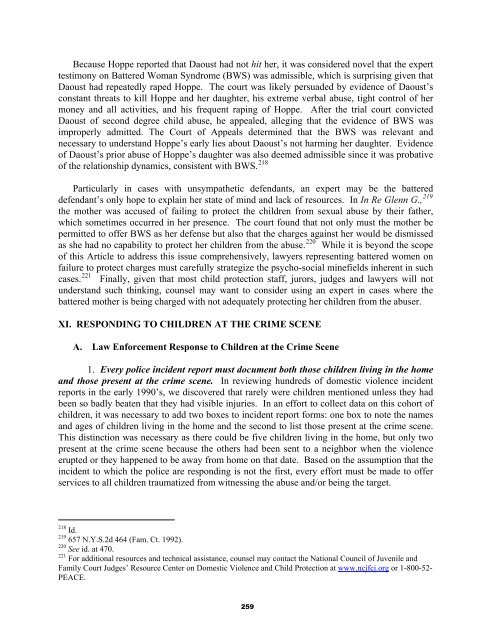A Judge’s Guide
A Judge’s Guide
A Judge’s Guide
You also want an ePaper? Increase the reach of your titles
YUMPU automatically turns print PDFs into web optimized ePapers that Google loves.
Because Hoppe reported that Daoust had not hit her, it was considered novel that the expert<br />
testimony on Battered Woman Syndrome (BWS) was admissible, which is surprising given that<br />
Daoust had repeatedly raped Hoppe. The court was likely persuaded by evidence of Daoust’s<br />
constant threats to kill Hoppe and her daughter, his extreme verbal abuse, tight control of her<br />
money and all activities, and his frequent raping of Hoppe. After the trial court convicted<br />
Daoust of second degree child abuse, he appealed, alleging that the evidence of BWS was<br />
improperly admitted. The Court of Appeals determined that the BWS was relevant and<br />
necessary to understand Hoppe’s early lies about Daoust’s not harming her daughter. Evidence<br />
of Daoust’s prior abuse of Hoppe’s daughter was also deemed admissible since it was probative<br />
of the relationship dynamics, consistent with BWS. 218<br />
Particularly in cases with unsympathetic defendants, an expert may be the battered<br />
defendant’s only hope to explain her state of mind and lack of resources. In In Re Glenn G., 219<br />
the mother was accused of failing to protect the children from sexual abuse by their father,<br />
which sometimes occurred in her presence. The court found that not only must the mother be<br />
permitted to offer BWS as her defense but also that the charges against her would be dismissed<br />
as she had no capability to protect her children from the abuse. 220 While it is beyond the scope<br />
of this Article to address this issue comprehensively, lawyers representing battered women on<br />
failure to protect charges must carefully strategize the psycho-social minefields inherent in such<br />
cases. 221 Finally, given that most child protection staff, jurors, judges and lawyers will not<br />
understand such thinking, counsel may want to consider using an expert in cases where the<br />
battered mother is being charged with not adequately protecting her children from the abuser.<br />
XI. RESPONDING TO CHILDREN AT THE CRIME SCENE<br />
A. Law Enforcement Response to Children at the Crime Scene<br />
1. Every police incident report must document both those children living in the home<br />
and those present at the crime scene. In reviewing hundreds of domestic violence incident<br />
reports in the early 1990’s, we discovered that rarely were children mentioned unless they had<br />
been so badly beaten that they had visible injuries. In an effort to collect data on this cohort of<br />
children, it was necessary to add two boxes to incident report forms: one box to note the names<br />
and ages of children living in the home and the second to list those present at the crime scene.<br />
This distinction was necessary as there could be five children living in the home, but only two<br />
present at the crime scene because the others had been sent to a neighbor when the violence<br />
erupted or they happened to be away from home on that date. Based on the assumption that the<br />
incident to which the police are responding is not the first, every effort must be made to offer<br />
services to all children traumatized from witnessing the abuse and/or being the target.<br />
218 Id.<br />
219 657 N.Y.S.2d 464 (Fam. Ct. 1992).<br />
220 See id. at 470.<br />
221 For additional resources and technical assistance, counsel may contact the National Council of Juvenile and<br />
Family Court Judges’ Resource Center on Domestic Violence and Child Protection at www.ncjfcj.org or 1-800-52-<br />
PEACE.<br />
259


